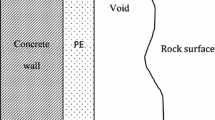Abstract
The internal structure and the integrity of the containment walls are aspects of landfill site management that need to be continuously monitored. Monitoring currently involves construction of boreholes and chemical analyses of surface samples which are time-consuming and expensive. The applicability of ground penetrating radar (GPR) as an aid to monitoring these processes has been investigated. GPR surveys have successfully resolved the shallow depth soil and geological structure, identified the structure and history of the waste input, defined the water table in three dimensions and identified leachout breakout points in the impermeable lining of the landfill edges. Integration of the results of GPR surveys with data from surface surveys and boreholes could provide landfill operators, environmental agencies and commercial companies with a cost-effective monitoring methodology and a mechanism for enhancing contaminant migration modelling.







Similar content being viewed by others
References
Abbaspour K, Matta V, Huggenberger P, Johnson CA (2000) A contaminated site investigation: a comparison of information gained from geophysical measurements and hydrogeological modeling. J Contaminant Hydrol 40:365–380
Ali JW, Hill IA (1991) Reflection seismics for shallow geological investigations—a case study from central England. J Geol Soc Lond 148:219–222
Annan AP (1993) Practical processing of GPR data. In: Proc 2nd Government Worksh on Ground Penetrating Radar, Columbus, Ohio
Annan AP, Cosway SW (1992) Ground penetrating radar survey design. In: Proc Symp on The Application of Geophysics to Environmental and Engineering Problems (SAGEEP '92), pp 191–208
Asante-Duah DK (1996) Managing contaminated sites. Wiley-Interscience, Chichester, UK
Brun A, Engesgaard P (2002) Modelling of transport and biogeochemical processes in pollution plumes: literature review and model development J Hydrol 256:211–227
Butt TE, Oduyemi KOK (2003) A holistic approach to concentration assessment of hazards in the risk assessment of landfill leachate. Environ Int 28:597–608
Davis JL, Annan AP (1989) Ground penetrating radar for high resolution mapping of soil and rock stratigraphy. Geophys Prospect 37:531–551
De Iaco R, Green AG, Maurer HR, Horstmeyer H (2003) A combined seismic reflection and refraction study of a landfill and its host sediments. J Appl Physics 1408:1–18
Fatta D, Naoum D, Loizidou M (2002) Integrated environmental monitoring and simulation system for use as a management decision support tool in urban areas. J Environ Manage 64:333–343
Forde MC (1996) Accuracy of GPR on contaminated land. In: Proc 4th Int Conf on Polluted and Marginal Land, London, pp 443–450
Knight R (2001) Ground penetrating radar for environmental applications. Annu Rev Earth Planet Sci 29:229–255
Liner CL, Liner JL (1995) Ground penetrating radar: a near-surface experience from Washington County, Arkansas. Leading Edge 14:17–21
Liu G, Yonggang J, Liu H, Qiu H, Qiu D, Shan H (2002) Environ Sci Technol 36:1077–1085
Meju MA (2000) Geoelectrical investigation of old/abandoned, covered landfill sites in urban areas: model development with a genetic diagnosis approach. J Appl Geophys 44:115–150
Nobes DC (1996) Troubled waters: environmental applications of electrical and electromagnetic methods. Surv Geophys 17:393–454
Padaraze I, Forde MC (1994) Limits of effectiveness of digital impulse radar in contaminated land site investigation. In: Proc 3rd Int Conf on Polluted and Marginal Land, pp 397–401
Peters L, Daniels JJ, Young JD (1994) Ground-penetrating radar as a subsurface environmental sensing tool. In: Proc IEEE '82, pp 1802–1822
Reynolds JM, Taylor DI (1992) The use of sub-surface imaging techniques in the investigation of contaminated sites. In: Proc 2nd Int Conf on polluted and marginal land, London, pp 121–131
Trenholme NM, Bentley LR (1998) The use of ground penetrating radar to accurately determine water table depths. In: Bell R, Powers M, Larson T (eds) Proc Symp on The Application of Geophysics to Environmental and Engineering Problems (SAGEEP '98), Environmental and Engineering Geophysics Society, Chicago, pp 829–838
Acknowledgements
This work was supported by equipment loans from the NERC Geophysical Equipment Pool. Miss Splajt's studentship was funded by Landfill Tax Credits through Enventure Northern.
Author information
Authors and Affiliations
Corresponding author
Rights and permissions
About this article
Cite this article
Splajt, T., Ferrier, G. & Frostick, L.E. Application of ground penetrating radar in mapping and monitoring landfill sites. Env Geol 44, 963–967 (2003). https://doi.org/10.1007/s00254-003-0839-5
Received:
Accepted:
Published:
Issue Date:
DOI: https://doi.org/10.1007/s00254-003-0839-5




